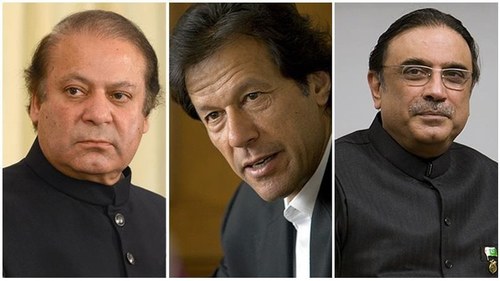
SINCE the emergence of the PTI as the PML-N’s chief rival in Punjab, some observers have periodically voiced concerns about rampant polarisation in the electorate. What’s cited as proof is the deeply partisan identities adopted by supporters both offline and on social media, which render any conversation skirting the issue of politics into an often tedious zero-sum exchange. In recent months, as we inch closer to the election, these exchanges have escalated in both quantity and their degree of hostility, leaving large social gatherings (on or offline) completely unbearable.
This is not the first time Pakistan has witnessed political polarisation. The 1990s, by all accounts, were deeply conflictual, with intra-elite as well as party-based conflict escalating throughout the decade. But most famously perhaps, it was the late 1960s and the 1970s that remain the high point of political polarisation, where ideological (more than party-based) identities permeated all forms of social interaction — from within the household, to student unions in educational institutions, to labour unions fighting management in workplaces, and finally, parties representing clear ideological platforms duking it out in the political arena.
It is fashionable to discard the political landscape of those two decades as either a relic or an anomaly by comparing it to the global context in the time since. However, in contrast to the seemingly post-ideological 1990s and early 2000s, the last decade or so has seen the global emergence of a more assertive ideological politics — largely of the right, but occasionally of a more progressive bent as well. The most obvious manifestation has been the rise of strongman authoritarian populism in different parts of the world, but a slightly less heralded one is the localised progressive activism, encapsulated by organisations like the Democratic Socialists of America, or Momentum in UK, or other such counterparts in Western Europe.
In an ideological vacuum, the non-cosmetic difference between the PTI and the PML-N is always going to be marginal.
None of this is particularly new given how party-based ideological identification has a long history in advanced democracies. In fact, plenty of research in the US and UK now concludes that partisan identity (rather than the classical sociological variables — class, gender, or race) is the best predictor of an individual’s view on various public issues.
While we’re quite some way away from this becoming a norm in Pakistan, deep identification with a party might already be true for certain segments of the population. People are quick to change their positions (and then fight passionately for their new ones) on the cue of their favoured party or leader. Many of those who advocated for the separation of religion from politics in the aftermath of the Khatm-i-Nabuwat amendment episode, suddenly found themselves questioning Imran Khan’s eligibility to be prime minister after his visit to a shrine. Similarly, those who passionately plead against the evils of feudalism and rural oppression are now creating elaborate justifications for their need in electoral politics.
A part, if not all, of this partisanship can be traced to the fact that politics is also the dominant form of cultural consumption on our airwaves. Because we don’t have the Pakistan Super League for more than two months a year, and because there’s no other sphere of cultural activity large enough to garner more of our attention, we’re perhaps left only with political arguments as a way to satiate partisan cravings or identity crises.
On the face of it, partisanship is not necessarily a bad thing. Increase in party vote banks is an unequivocal positive for a political system that has too long remained dependent on the clout of individual candidates and their families. It also increases some pressure on parties to respond to their core electorates, as they become more easily identifiable and vocal.
However, unlike the divisive partisanship we see between Labour and Conservative supporters in the UK, or the Democrats and Republicans in the US, the Pakistani brand of partisanship (specifically the PML-N vs PTI tedium) is a slightly bewildering phenomenon, given its relative lack of grounding in any ideological or programmatic difference. This is not to say there aren’t any differences between the two parties — there are on a number of issues, including some development priorities and devolution. However, the overarching framework in both manifestos is growth-oriented, with even the design of social protection programmes mirroring each other. Hence, most of all, this visceral partisanship is based on the appeal of party leaders, rather than anything else.
If there were more substantive differences driving it, we would’ve seen PTI supporters questioning the party’s embrace of a variety of expedient electoral strategies and personalities, which weaken its claim of difference and will undoubtedly shape its performance in office. Similarly, it would force PML-N supporters to question the narrative of civilian supremacy being vocalised by the leadership now, after five years of ceding turf, seeking deals, or ignoring these major contradictions while in office.
The truth is that in an ideological vacuum, the non-cosmetic difference between two urban-centred, elite-run parties is always going to be marginal. People can debate endlessly about the PTI’s fixation with corruption, and the PML-N’s fixation with infrastructure, but the fact is that in office, the pursuit of economic and social policy will not differ by much, given the existing capacity and fiscal constraints.
Rest assured, once the PTI steps into government in a few weeks’ time, it will spend its first few years exactly how nearly every government in Pakistan’s history has — by fighting off a balance-of-payments crisis that usually leads to high inflation, and low growth. As we head to the polls in a matter of weeks, it is probably worth taking a dispassionate moment and thinking about the similarities between the two main parties, simply as a way to reduce the general air of toxicity that so many of us are often caught up in.
The writer is a freelance columnist.
Twitter: @umairjav
Published in Dawn, July 16th, 2018












































